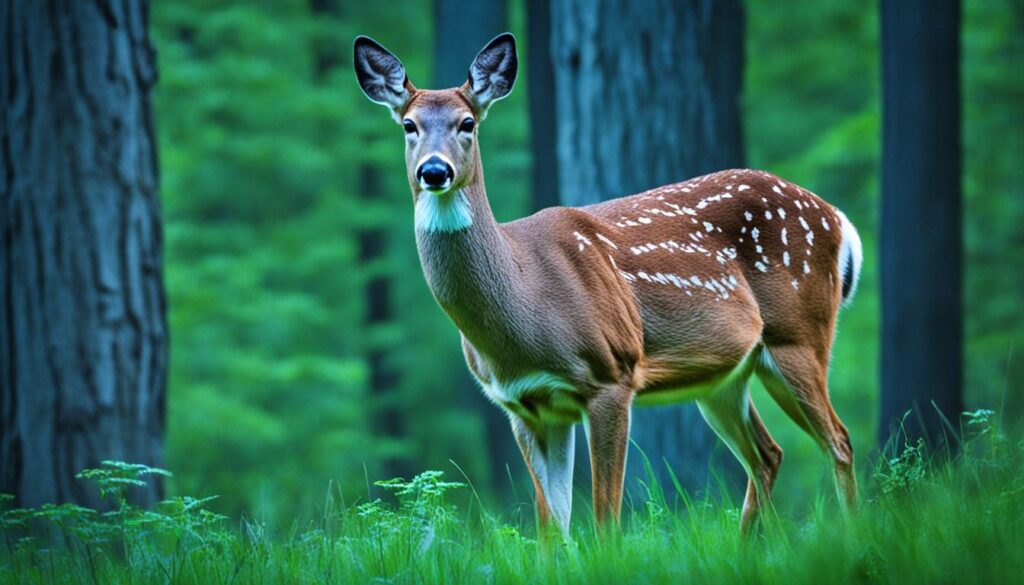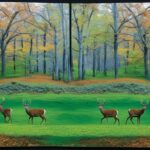When it comes to hunting, understanding deer vision is essential for a successful expedition. Recent research conducted at the University of Georgia (UGA) has shed light on the fascinating world of deer eyesight and their perception of colors, including green light. Let’s explore what we know about deer vision and their ability to perceive green light.
Deer, particularly whitetail deer, have remarkable vision that is specifically adapted for their survival in the wild. Their eyes are strategically positioned to provide a wide field of view, with about 65 degrees of binocular vision and 300-310 degrees overall. They are most sensitive to colors in the blue spectrum, which is abundant during the dim light of dawn and dusk. However, their ability to distinguish between green and red or orange and red is limited.
Deer vision is sharper in light grays and tans compared to dark reds, browns, and greens. In fact, deer have better visual acuity than humans, particularly in low-light conditions. Their eyes are highly adapted to detecting movement and potential threats, making them incredibly vigilant in their natural habitat.
Content Highlights
ToggleKey Takeaways:
- Deer have excellent vision, with about 65 degrees of binocular vision and 300-310 degrees overall.
- Deer are most sensitive to colors in the blue spectrum, making them highly adapted to detecting movement during low-light conditions.
- They struggle to differentiate between green and red or orange and red.
- Deer vision is sharper in light grays and tans compared to dark reds, browns, and greens.
- Deer have better visual acuity than humans, particularly in low-light conditions.
How Do Deer Perceive Colors?
The color perception of deer is influenced by the structures of their eyes and the specific photoreceptor cells they possess. While deer have both cones and rods in their eyes like humans, they have fewer cones, which impacts their color vision.
Cones: These photoreceptor cells are responsible for color vision and are most sensitive to short (blue) and middle (green) wavelength colors. Deer can distinguish blues up to 20 times better than humans, which gives them a distinct advantage in perceiving colors within the blue spectrum. However, they struggle with longer wavelength colors like red and orange.
Red-green colorblindness: Deer are essentially red-green colorblind, meaning they perceive these colors as various shades of yellow. This color deficiency is due to the absence of a yellow filter in their eyes. However, their ability to see blues more vividly compensates for this limitation. This natural adaptation enables them to navigate and detect movement more effectively in low-light conditions when the blue spectrum is more prevalent, especially during dawn and dusk.

Table: Deer Color Vision Comparison
| Deer | Humans | |
|---|---|---|
| Color Sensitivity | High sensitivity to blues | Balanced sensitivity across visible spectrum |
| Red Perception | Perceived as shades of yellow | Perceived as red |
| Overall Color Range | Limited color discrimination | Broad color discrimination |
Deer Vision in Different Light Conditions
Deer have exceptional night vision, allowing them to navigate and detect potential threats during the night. Their eyes have a high concentration of rod cells, which are responsible for low-light vision, enabling them to see in almost complete darkness. The oval shape of their pupils acts as an aperture, controlling the amount of light entering the eye.
Deer’s night vision capabilities are further enhanced by a specialized layer of tissue called the tapetum lucidum. This layer acts as a mirror, reflecting and amplifying light, thereby increasing the sensitivity of their rod cells. As a result, deer can effectively utilize the limited available light for improved vision in low-light conditions.
However, this heightened sensitivity to light comes at a cost. During low-light or dark conditions, the rod cells dominate the deer’s visual perception, restricting their ability to detect colors. Consequently, their vision shifts towards grayscale, limiting their color vision capabilities.

While deer may not perceive colors accurately in low-light conditions, their rod cells provide them with a distinct advantage in detecting movement and potential threats. This adaptation aligns with their natural habitats, where the ability to identify movement is crucial for survival.
To summarize, the night vision of deer is highly specialized, primarily relying on rod cells to see in low-light conditions. This adaptation enables them to navigate and forage during the night, but comes at the expense of color vision. The exceptional night vision of deer is a remarkable adaptation that allows them to thrive in their nocturnal habitats.
The Impact of Clothing on Deer Perception
When it comes to clothing, deer have specific visual sensitivities that hunters need to consider. Deer are more sensitive to short-wavelength light, including ultraviolet (UV) light. Bright colors like orange may appear less vivid to deer compared to blues, which they can see more intensely.
However, some hunting apparel may contain UV brighteners that can make clothing appear brighter and more easily detectable by deer. Synthetic fabrics and certain laundry detergents may also reflect more blue light, making them stand out to deer.
It is recommended to use camo patterns with darker browns, greens, and blacks to blend better with typical whitetail habitats. Washing hunting clothes with detergents that do not contain UV brighteners and avoiding synthetic fabrics can help minimize visibility to deer. Ultimately, movement is more important than color when it comes to remaining undetected by deer.
- California Deer Hunting Guide: Seasons, Rules, Permits, and More - 26 June 2024
- Arkansas Deer Season 2024 [Schedules, Licenses, Bag Limits & More!] - 26 June 2024
- 2024 Arizona Deer Season New Dates & Rules! - 25 June 2024




